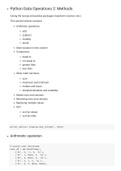Python Data Operations 2: Methods
(Using the numpy and pandas packages imported in section one.)
This second section contains:
Arithmetic operations
add
subtract
multiply
divide
Store solution in new column
Comparison
equal to
not equal to
greater than
less than
Other math functions
sum
maximum and minimum
median and mean
standard deviation and variability
Delete rows and columns
Renaming rows and columns
Replacing multiple values
Sort
sort by values
sort by index
pd.set_option('display.max_columns', None)
Arithmetic operation
# create test dataframe
test_df = pd.DataFrame([
['A3', 0, -1, 0, 'si'],
['B1', 1, None, 0, 'no'],
['B3', 4, None, 0, 'no'],
['B3', 5, 1, 0, 'si'],
['A1', 4, 0, None, None],
, ['A3', 1, 2, 1, 'si'],
['C2', 4, 1, 1, 'no']],
columns=['A', 'B', 'C', 'D', 'E'],
index=[f'R{i}' for i in range(7)]
)
test_df
A B C D E
R0 A3 0 -1.0 0.0 si
R1 B1 1 NaN 0.0 no
R2 B3 4 NaN 0.0 no
R3 B3 5 1.0 0.0 si
R4 A1 4 0.0 NaN None
R5 A3 1 2.0 1.0 si
R6 C2 4 1.0 1.0 no
#add 10 to column D
test_df['D'] + 10
R0 10.0
R1 10.0
R2 10.0
R3 10.0
R4 NaN
R5 11.0
R6 11.0
Name: D, dtype: float64
# subtracting a value from column D
test_df['D'] - 10
test_df['D'].sub(10)
R0 -10.0
R1 -10.0
R2 -10.0
R3 -10.0
R4 NaN
R5 -9.0
R6 -9.0
Name: D, dtype: float64
#the above operations will not update the dataframe
test_df




